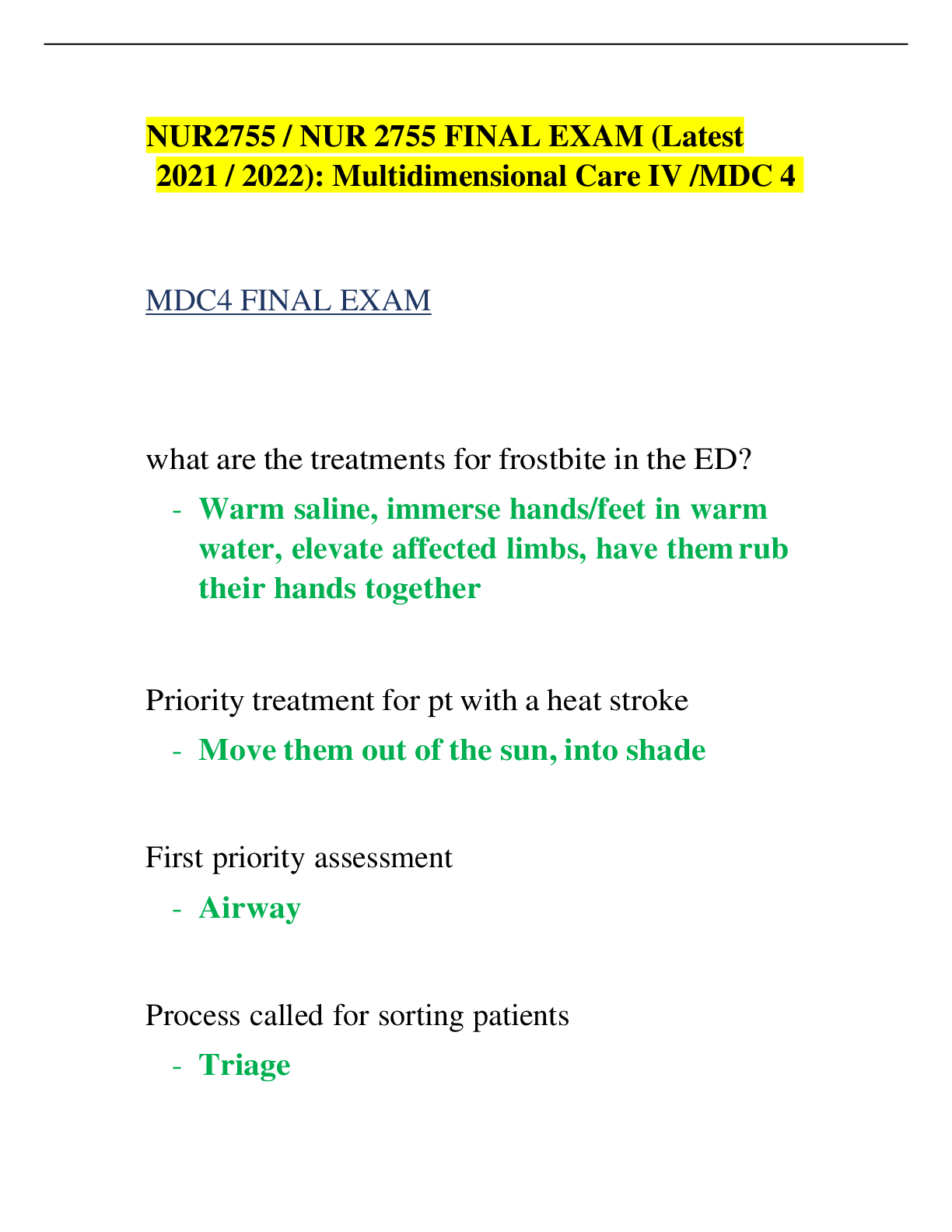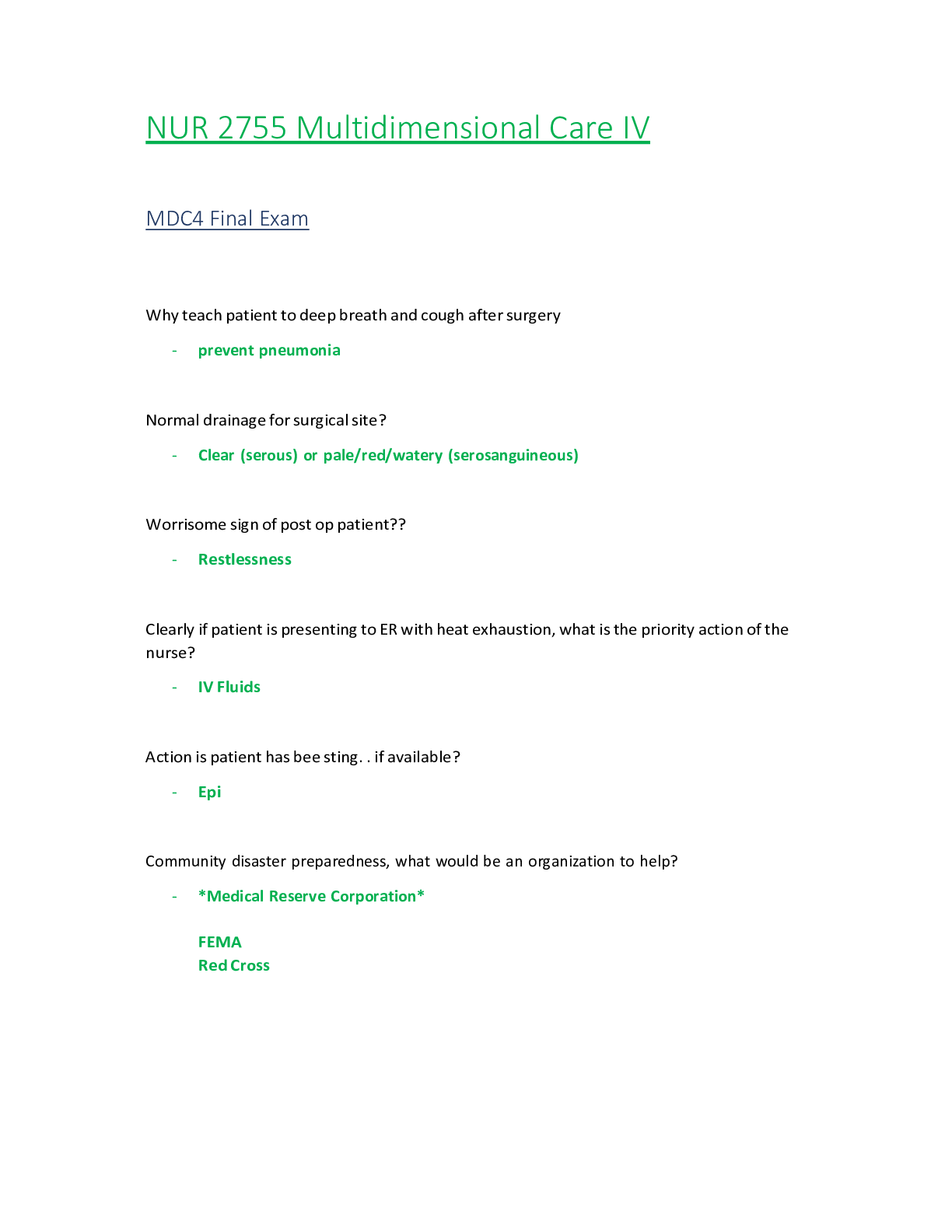Health Care > EXAM > NUR2755 / NUR 2755 Final Exam : Multidimensional Care IV / MDC 4 - Rasmussen (All)
NUR2755 / NUR 2755 Final Exam : Multidimensional Care IV / MDC 4 - Rasmussen
Document Content and Description Below
NUR2755 / NUR 2755 Final Exam : Multidimensional Care IV / MDC 4 - Rasmussen Alzheimer's Mild Stage Correct Answer: -Forgets names; misplaces household items -Has short-term memory loss and dif... ficulty recalling new information -Shows subtle changes in personality and behavior Alzheimer's Moderate Stage Correct Answer: -Is disoriented to time, place, and event -Has difficulty driving and gets lost -Incontinent -Psychotic behaviors, such as delusions, hallucinations, and paranoia -Episodes of wandering, trouble sleeping Alzheimer's Late Stage Correct Answer: -Totally incapacitated; bedridden -Totally dependent in ADLs -Has agnosia -Hallucinations -Incontinence -Difficulty eating Apraxia Correct Answer: Difficulty with motor planning to perform tasks or movements Aphasia Correct Answer: Inability to speak or understand language Anomia Correct Answer: Inability to recall the names of everyday objects Agnosia Correct Answer: Loss of sensory comprehension, including facial recognition Alzheimer's diagnostics Correct Answer: -No laboratory test can confirm the diagnosis of AD -Definitive diagnosis is made on the basis of brain tissue examination at autopsy, which confirms the presence of neurofibrillary tangles and neuritic plaques Alzheimer's medications Correct Answer: Cholinesterase inhibitors- Donepezil, galantamine NMDA receptor antagonists- Memantine Parkinson's symptoms Correct Answer: -Slow, shuffling, and propulsive gait -RESTING tremors -Muscle rigidity -Bradykinesia/akinesia (loss of ability to move muscles voluntarily) -Mask Like face -Drooling -Postural instability Parkinson's diagnostics Correct Answer: -Diagnosis typically made based on manifestations, their progression, and by ruling out other disease -Analysis of CSF may show a decrease in dopamine levels Parkinson's medications Correct Answer: Carbidopa/Levodopa (Sinemet) Parkinson's surgical interventions Correct Answer: Stereotactic pallidotomy or thalamotomy Migraine triggers Correct Answer: -Caffeine -Red wine -MSG -Foods high in tyramine (aged cheeses, cultured food like yogurt) Migraine abortive therapy Correct Answer: Acetaminophen, ibuprofen, naproxen, triptans, ergotamine derivatives Migraine preventative therapy Correct Answer: Beta blockers, calcium channel blockers, antiepileptics, Botox Migraine surgical treatment Correct Answer: Trigeminal nerve resection Aura symptoms Correct Answer: -Visual disturbances -Flashing lights/lines/spots -Numbness of lips or tongue -Acute confused state -Aphasia -Vertigo -Unilateral weakness* -Offensive smell -"Deja vu" feeling Multiple sclerosis clinical manifestations Correct Answer: -Muscle weakness and spasticity -Intention tremors (tremor when performing an activity) -Diplopia (double vision) -Nystagmus (an involuntary condition in which the eyes make repetitive uncontrolled movements) -Depression/labile Multiple sclerosis diagnosis Correct Answer: MRI of the brain and spinal cord demonstrates the presence of plaques in at least 2 areas Multiple sclerosis medications Correct Answer: -Baclofen -Disease-modifying therapies -Interferon beta-1a and beta-1b -Corticosteroids Meningitis clinical manifestations Correct Answer: -Nuchal rigidity -Kernig Sign -Brudzinski Sign -Decreased level of consciousness -Photosensitivity Kernig Sign Correct Answer: Resistance and pain with extension of the client's leg from a flexed position Brudzinski Sign Correct Answer: Flexion of the knees and hips occurring with deliberate flexion of the client's neck Meningitis diagnostics Correct Answer: Lumbar puncture Appearance of CSF: cloudy (bacterial) or clear (viral) Prevention of meningitis Correct Answer: Meningococcal vaccine Droplet precautions Correct Answer: -Private room -Stay at least 3 feet away from the patient unless wearing a mask -Patients who are transported outside the room should wear a mask -Health care personnel should wear gloves, gown, and mask Tonic-clonic seizure Correct Answer: Generalized seizure in which the patient loses consciousness and has both stiffening of the muscles (tonic) and rhythmic jerking of the extremities (clonic) Tonic seizure Correct Answer: Clients suddenly lose consciousness and experience sudden increased muscle tone, loss of consciousness, and have autonomic manifestations Clonic seizure Correct Answer: Only the clonic phase is experienced (rhythmic jerking of the extremities) Myoclonic seizure Correct Answer: Lasting only seconds, myoclonic seizures consist of brief jerking or stiffening of the extremities, which can be symmetrical or asymmetrical Atonic or akinetic seizure Correct Answer: Characterized by a few seconds in which muscle tone is lost Complex partial seizure Correct Answer: -Seizures associated with automatisms (behaviors that the client is unaware of, such as lip smacking or picking at clothes) -Can cause loss of consciousness Simple partial seizure Correct Answer: Seizure where consciousness is maintained Seizure diagnostics Correct Answer: -Electroencephalogram (EEG) -CT/MRI Seizure interventions Correct Answer: -Turn the patient on their side -Remove objects that may injure the patient -Suction as needed -Oxygen -Padded side rails -IV access (saline lock) -Bed in lowest position -Nothing in mouth -Loosen or remove restrictive clothing Seizure medications Correct Answer: -Lorazepam or diazepam IV push to stop a seizure (4 mg over a 2 minute period) -Phenytoin (therapeutic range 10 to 20 mcg/ml) Earliest sign of increased intracranial pressure Correct Answer: Decreased level of consciousness Increased intracranial pressure early signs Correct Answer: -EARLIEST SIGN: Decreased level of consciousness -Restlessness -Changes in speech -Confusion -Headache -Nausea and vomiting → projectile Increased intracranial pressure late signs Correct Answer: -Pupillary changes → can mean herniation -Cranial nerve dysfunction -Ataxia -Cushing's triad (very late sign) Increased intracranial pressure interventions Correct Answer: -Low stimulation -Semi-fowlers → 30 degrees -Head in neutral position -Do not cluster activities -Suction only as needed -Teach patient not to cough or blow their nose -Dim lighting -Stool softeners -Do not bend or bare down Increased intracranial pressure treatment Correct Answer: IV mannitol given through a filter because it crystallizes at room temperature Cushing's triad Correct Answer: Severe hypertension, widened pulse pressure (difference between the systolic and diastolic blood pressure), bradycardia, irregular respirations Pulse pressure Correct Answer: Difference between systolic and diastolic pressure Ischemic stroke Correct Answer: Caused by the occlusion of a cerebral artery by either a thrombus or an embolus. Thrombotic stroke Correct Answer: Occur secondary to the deve [Show More]
Last updated: 1 year ago
Preview 1 out of 18 pages
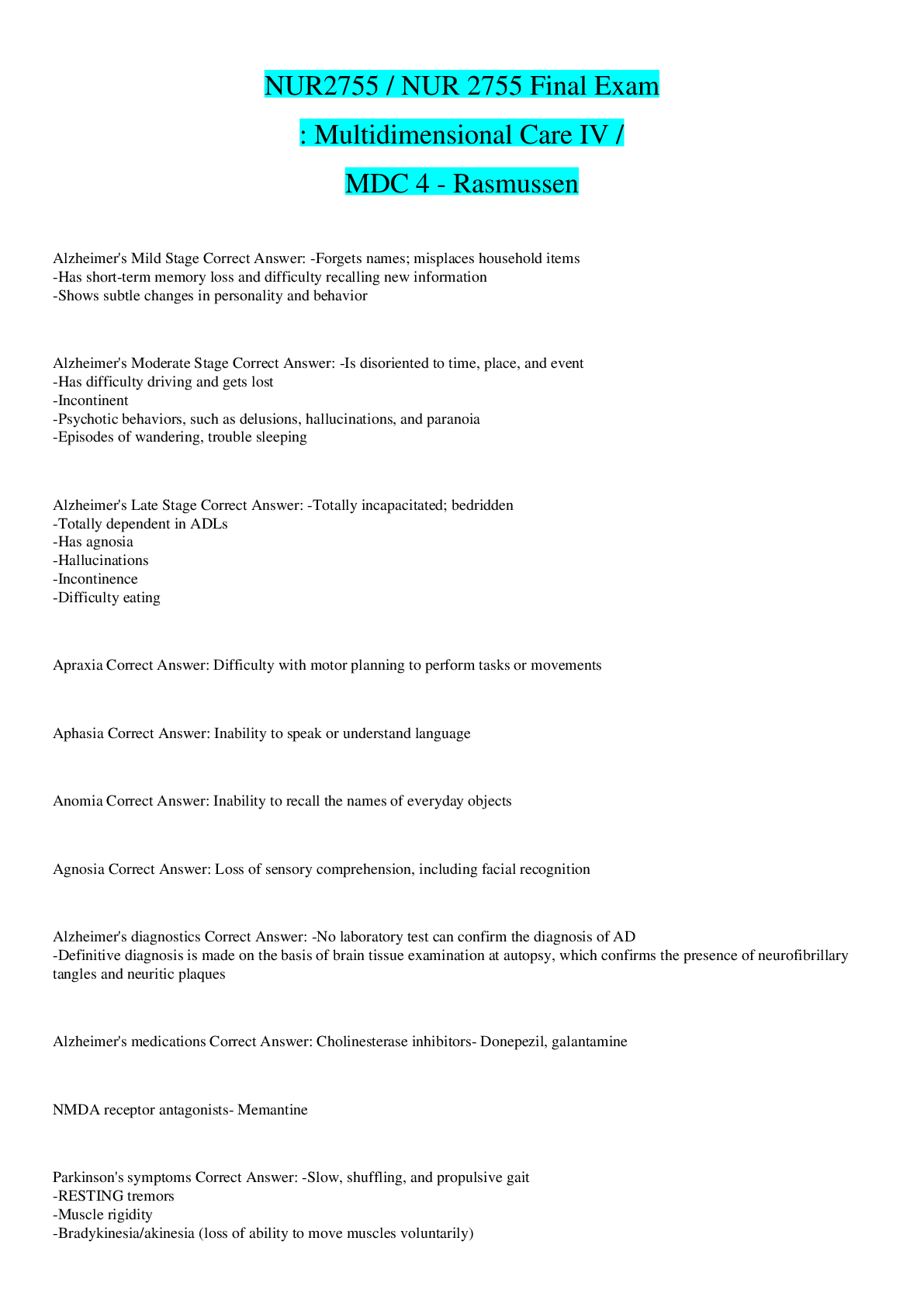
Reviews( 0 )
Document information
Connected school, study & course
About the document
Uploaded On
Jul 28, 2022
Number of pages
18
Written in
Additional information
This document has been written for:
Uploaded
Jul 28, 2022
Downloads
0
Views
49

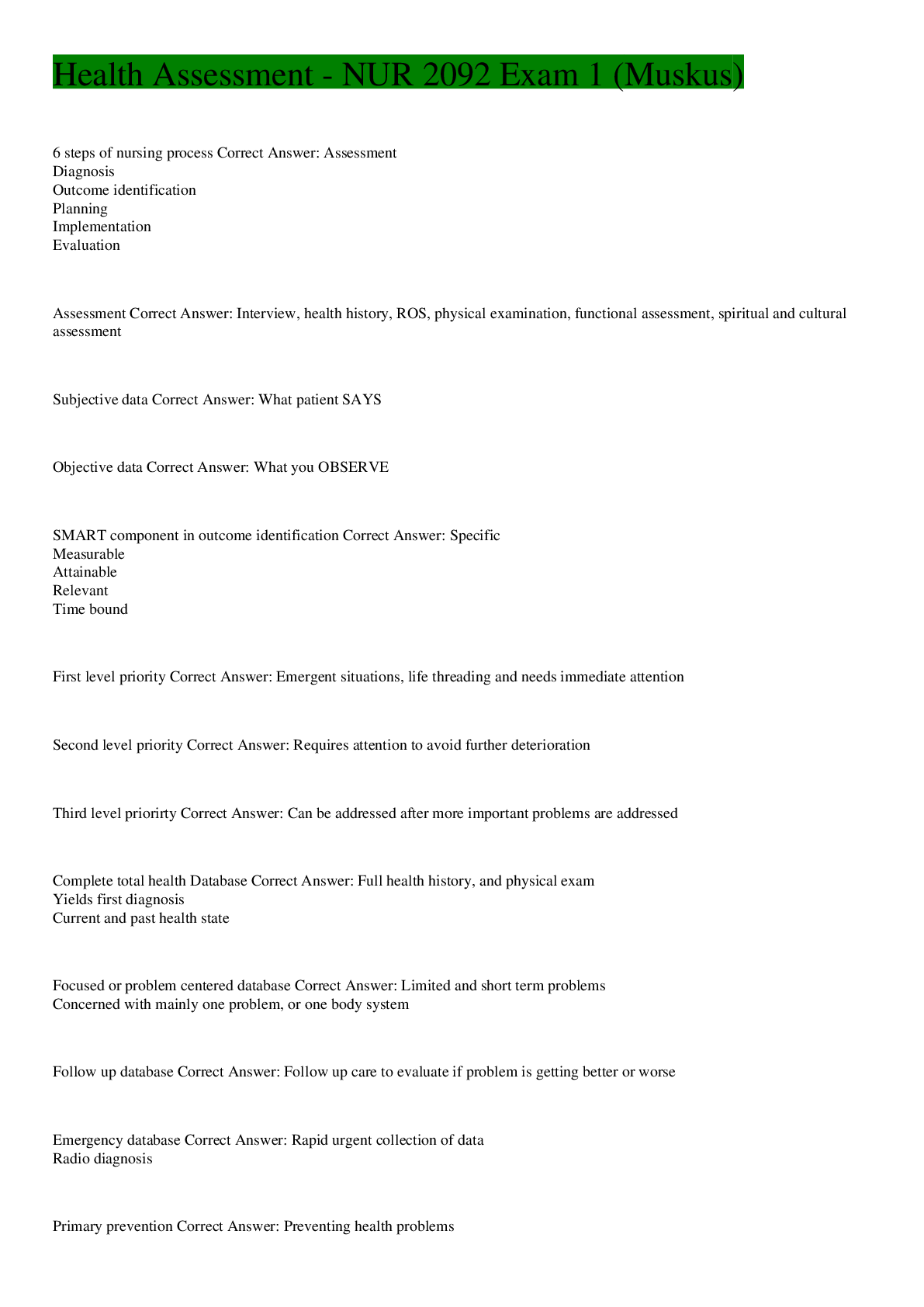
.png)
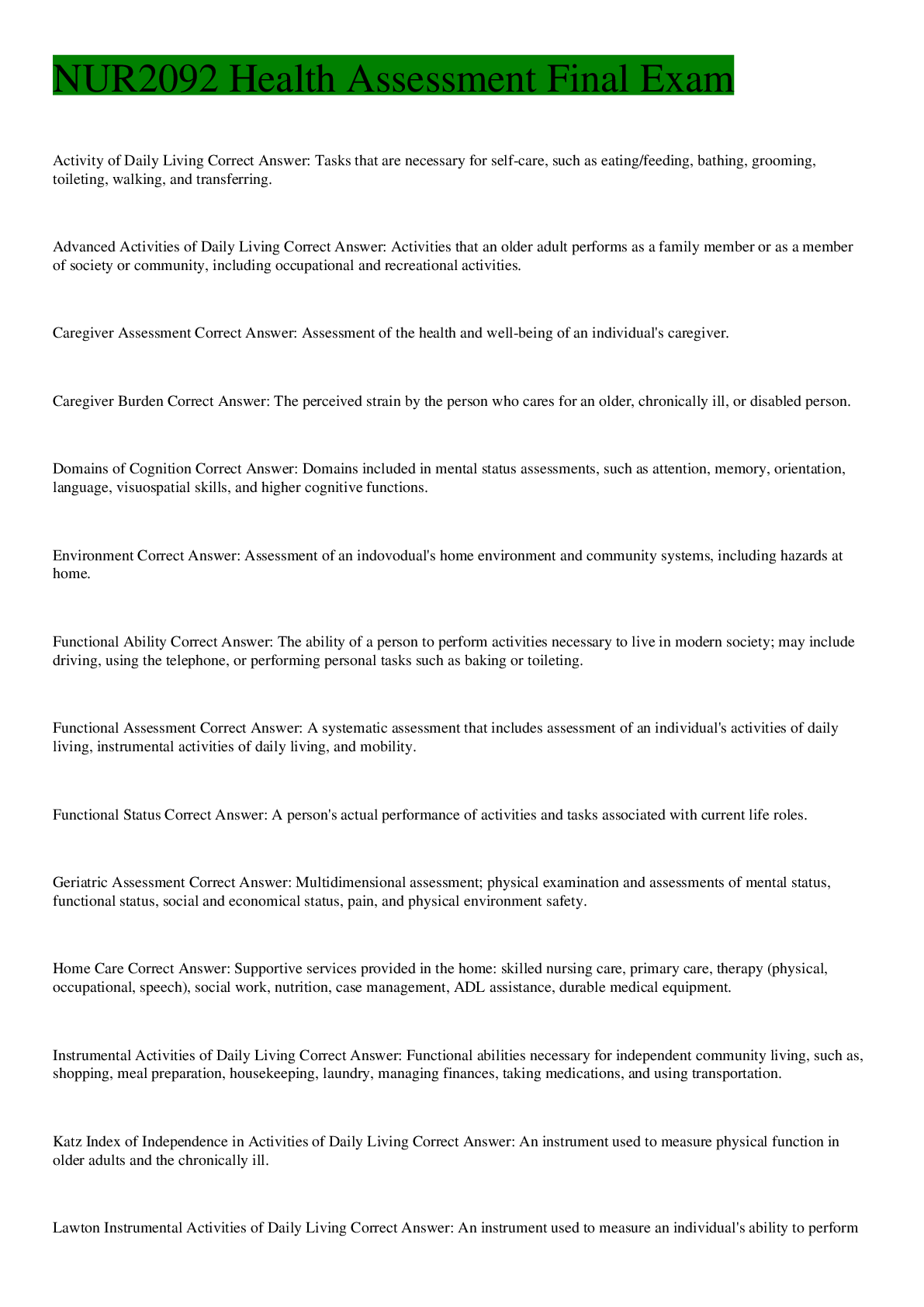
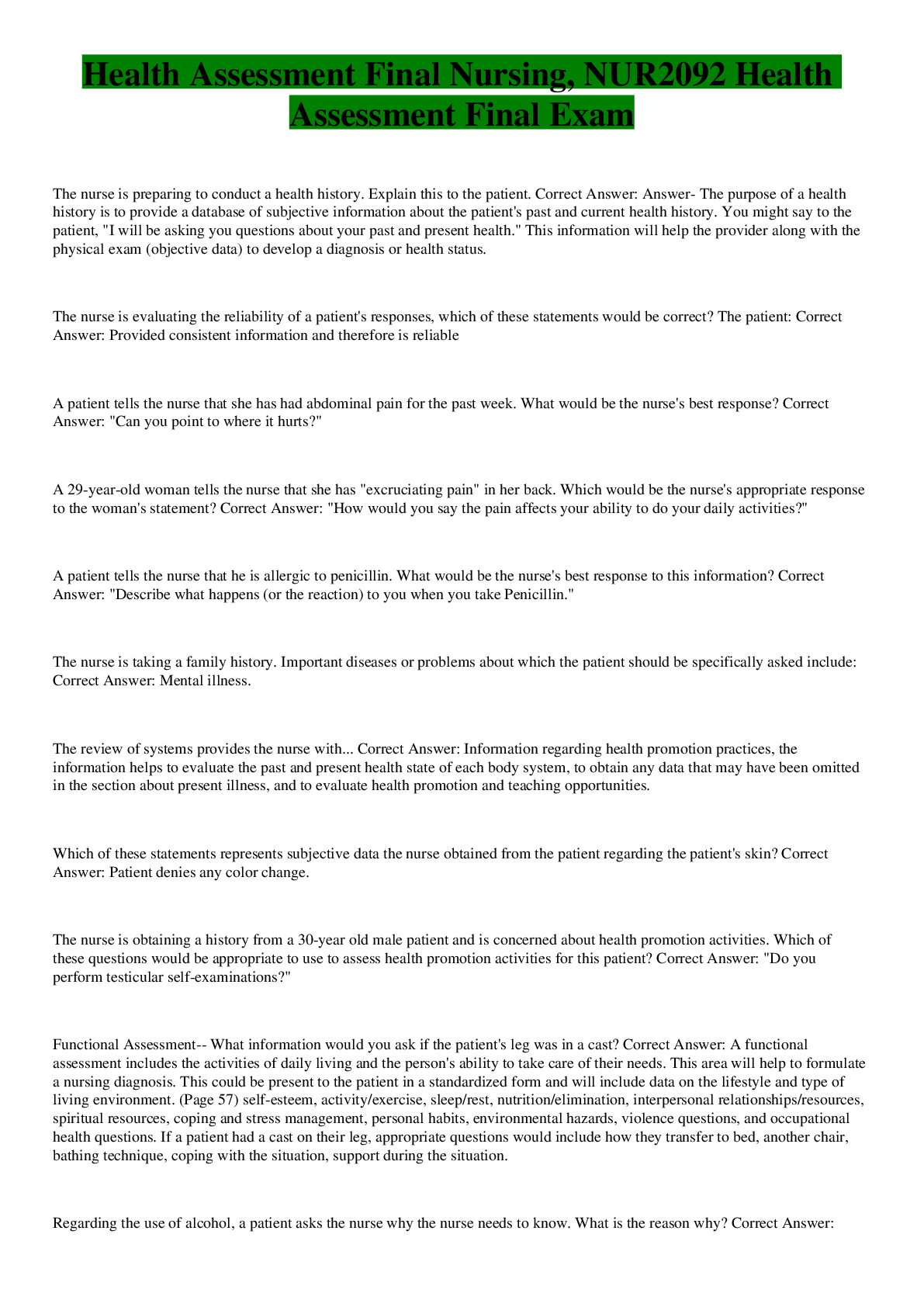
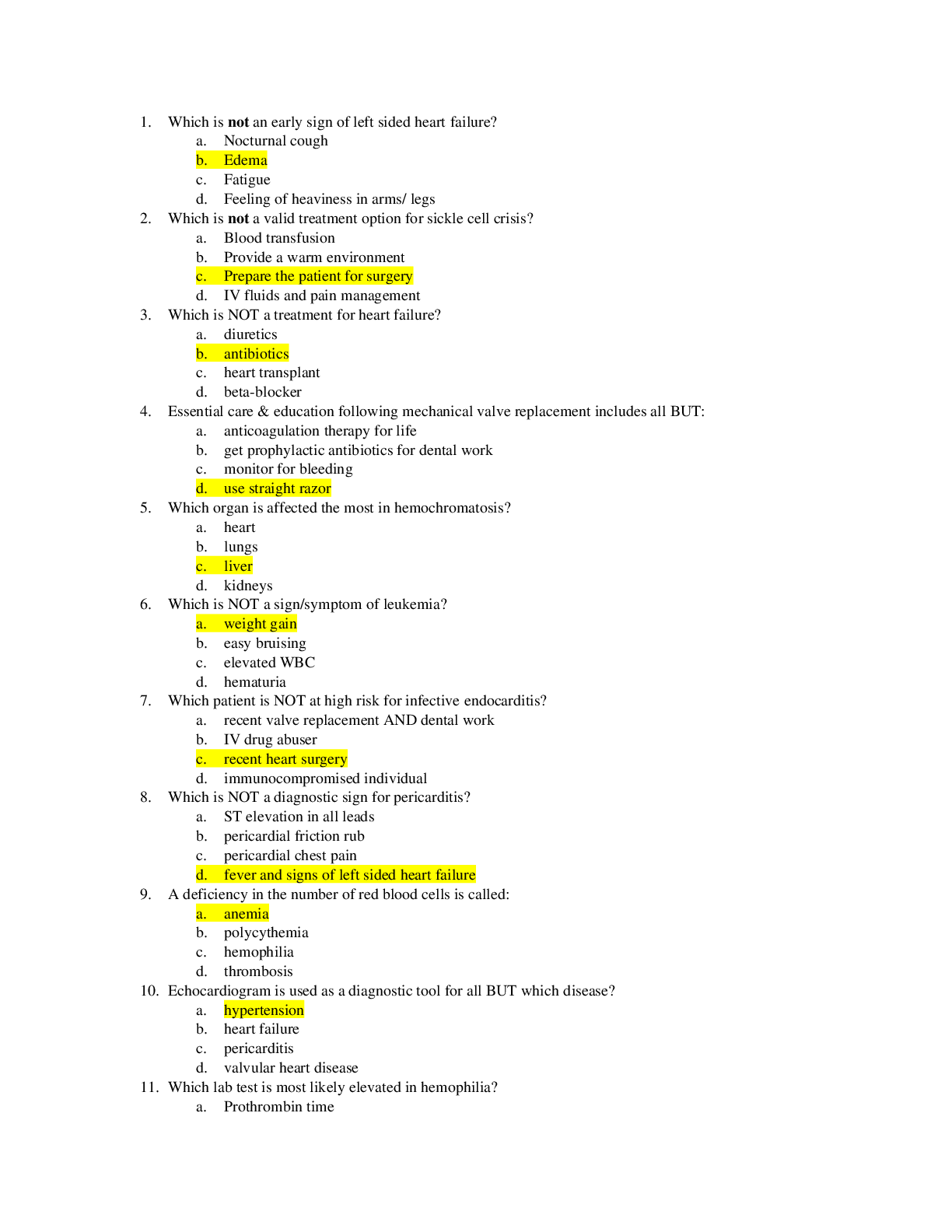
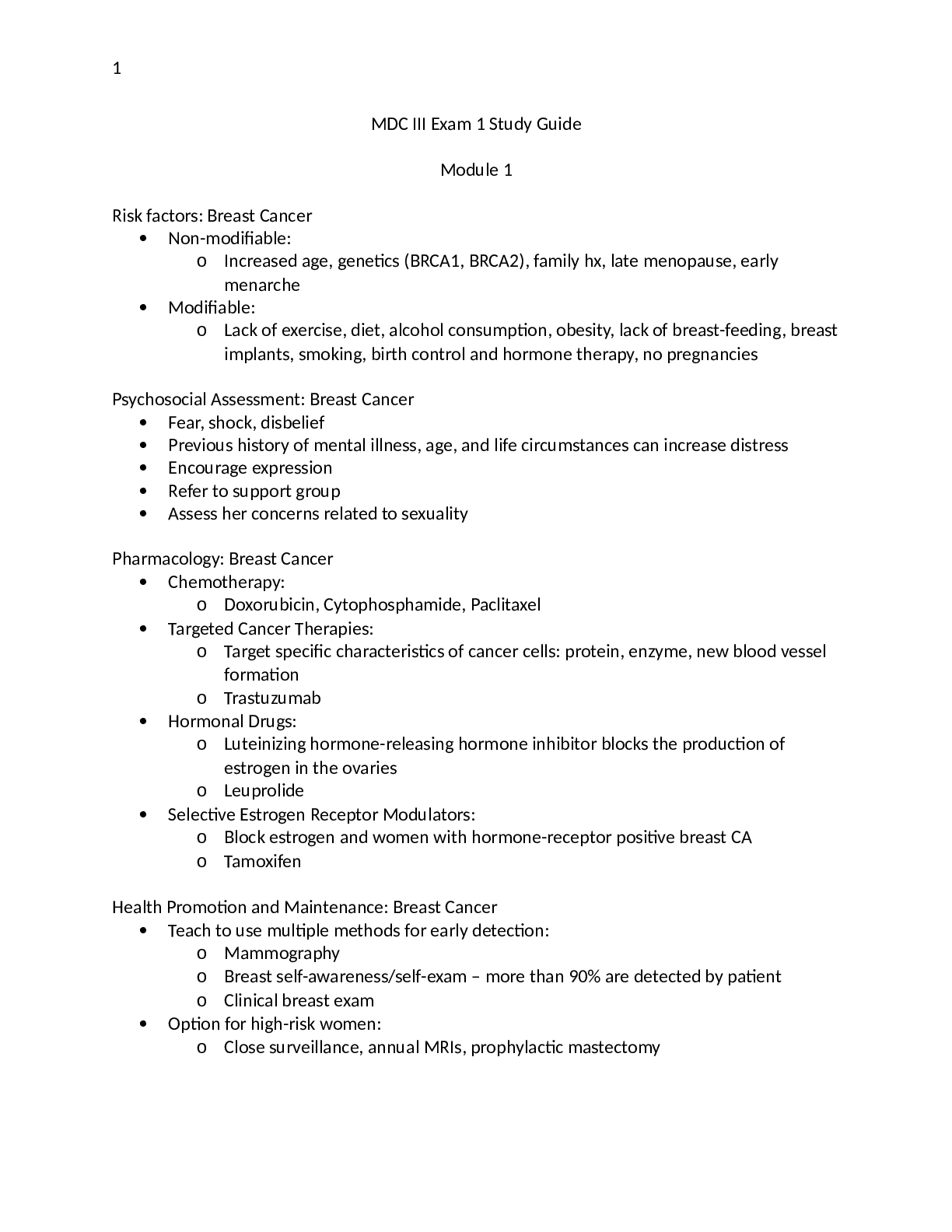

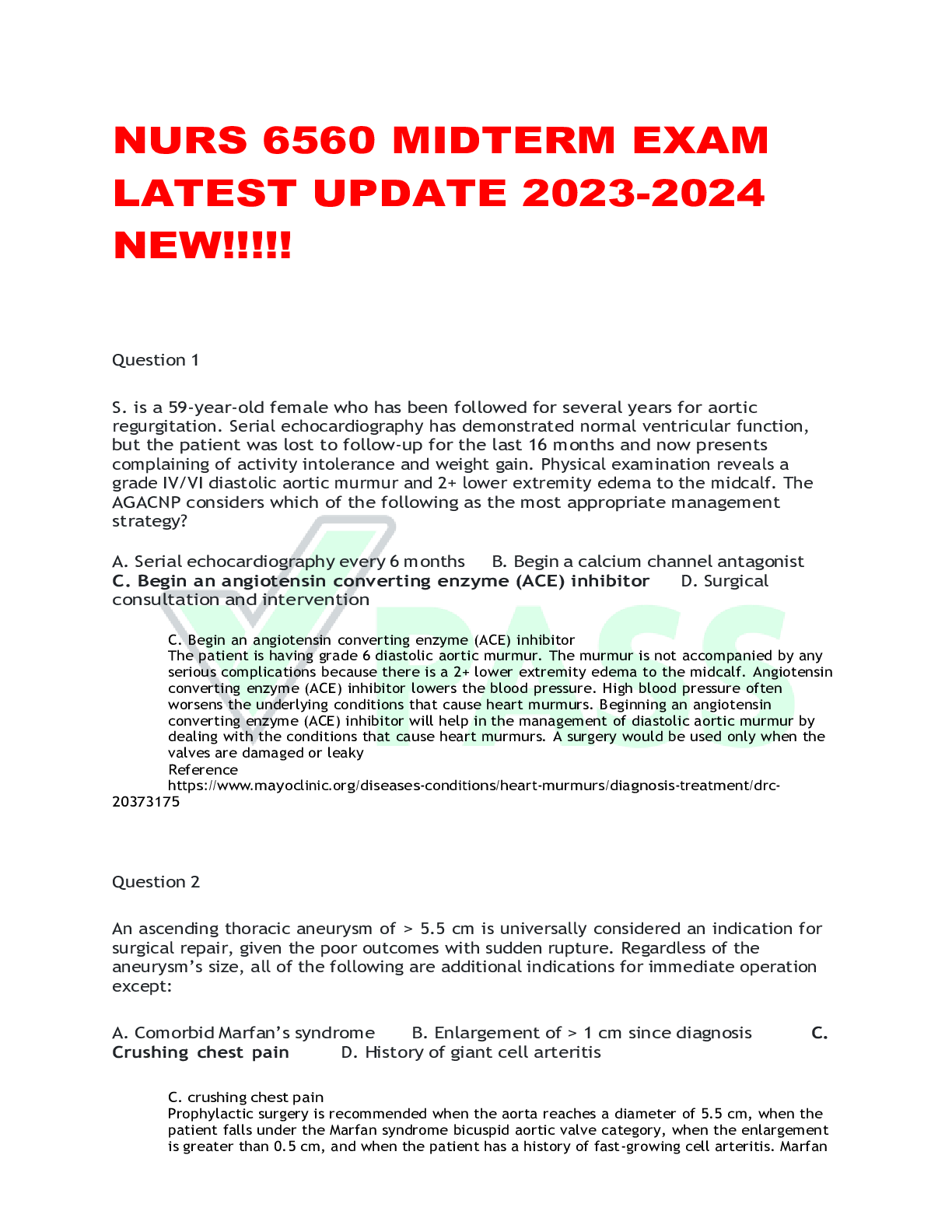
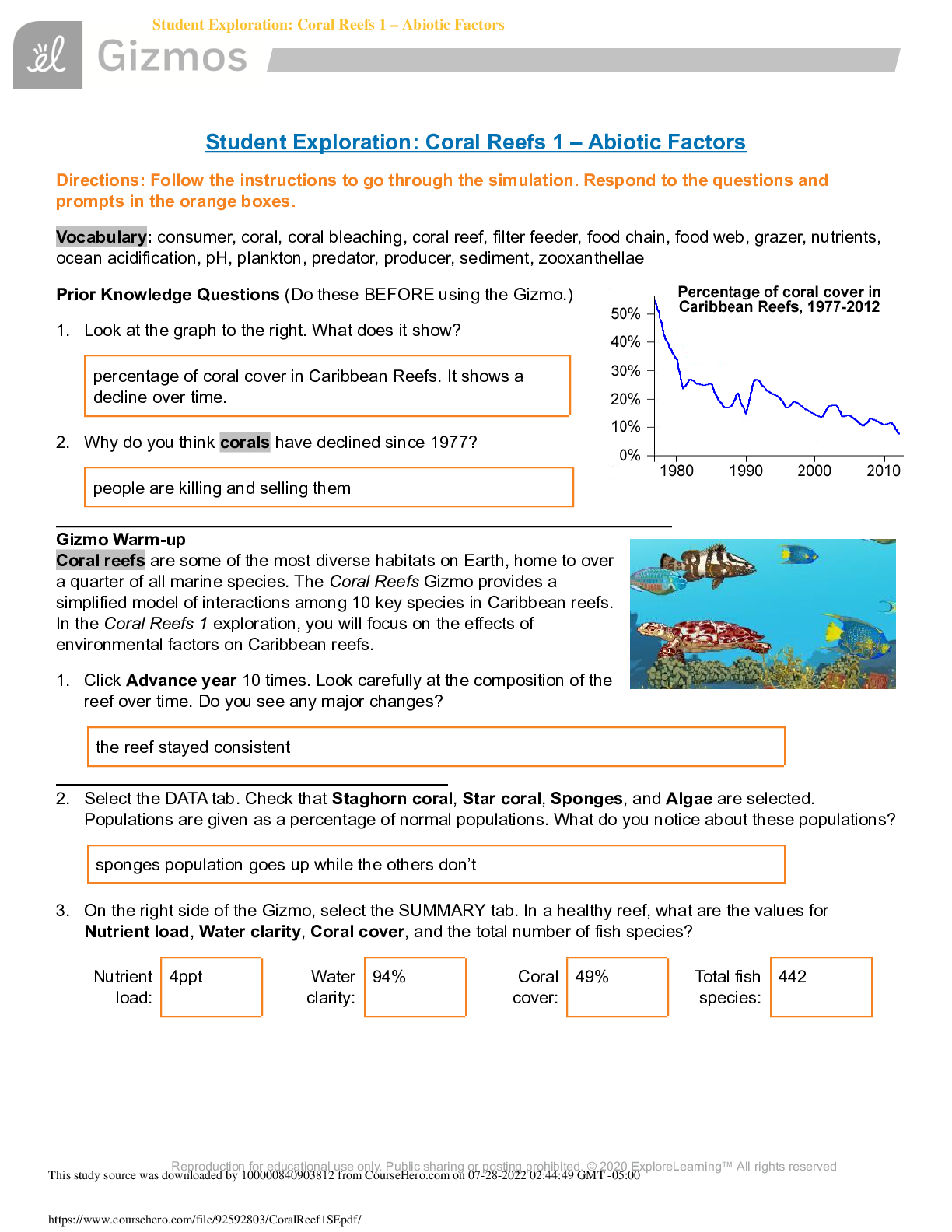
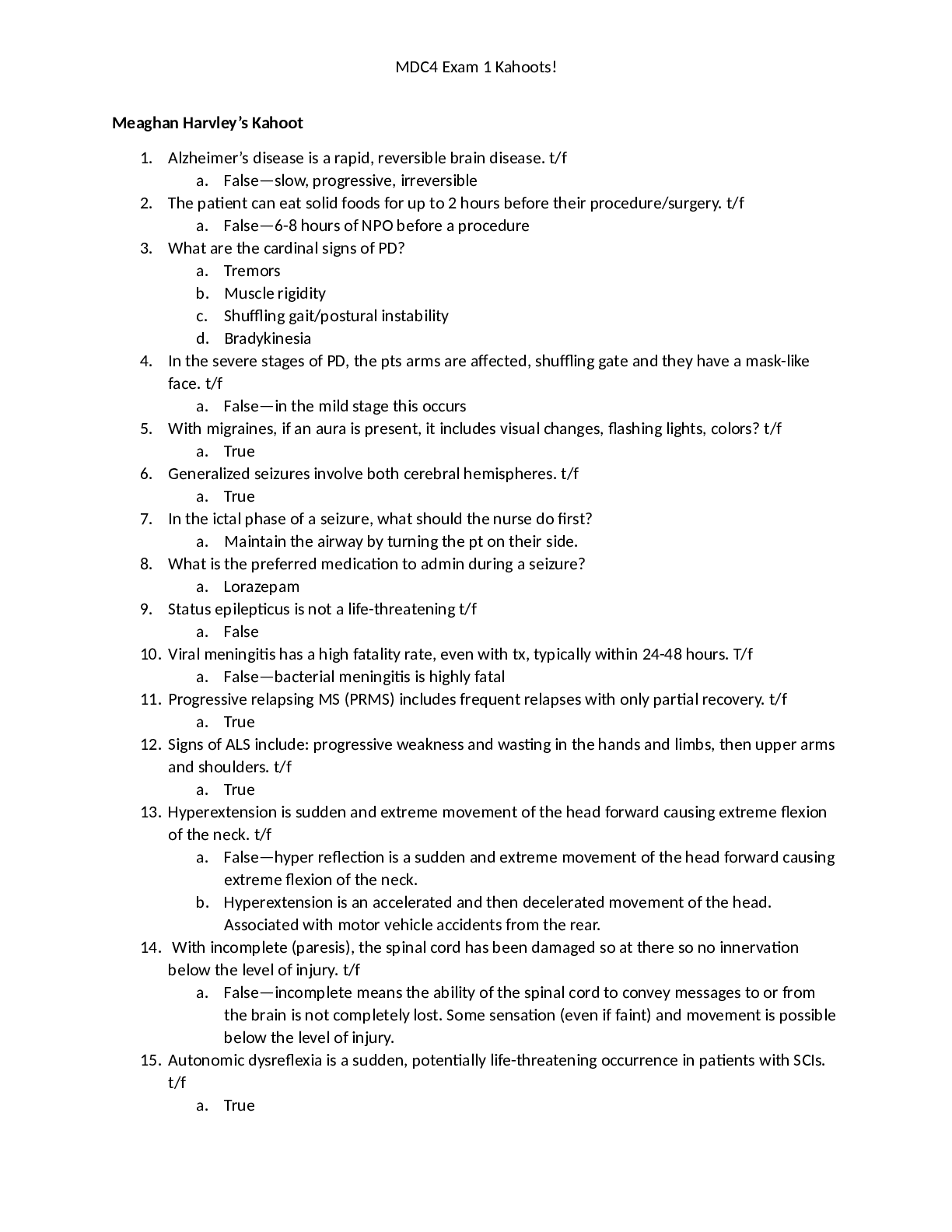
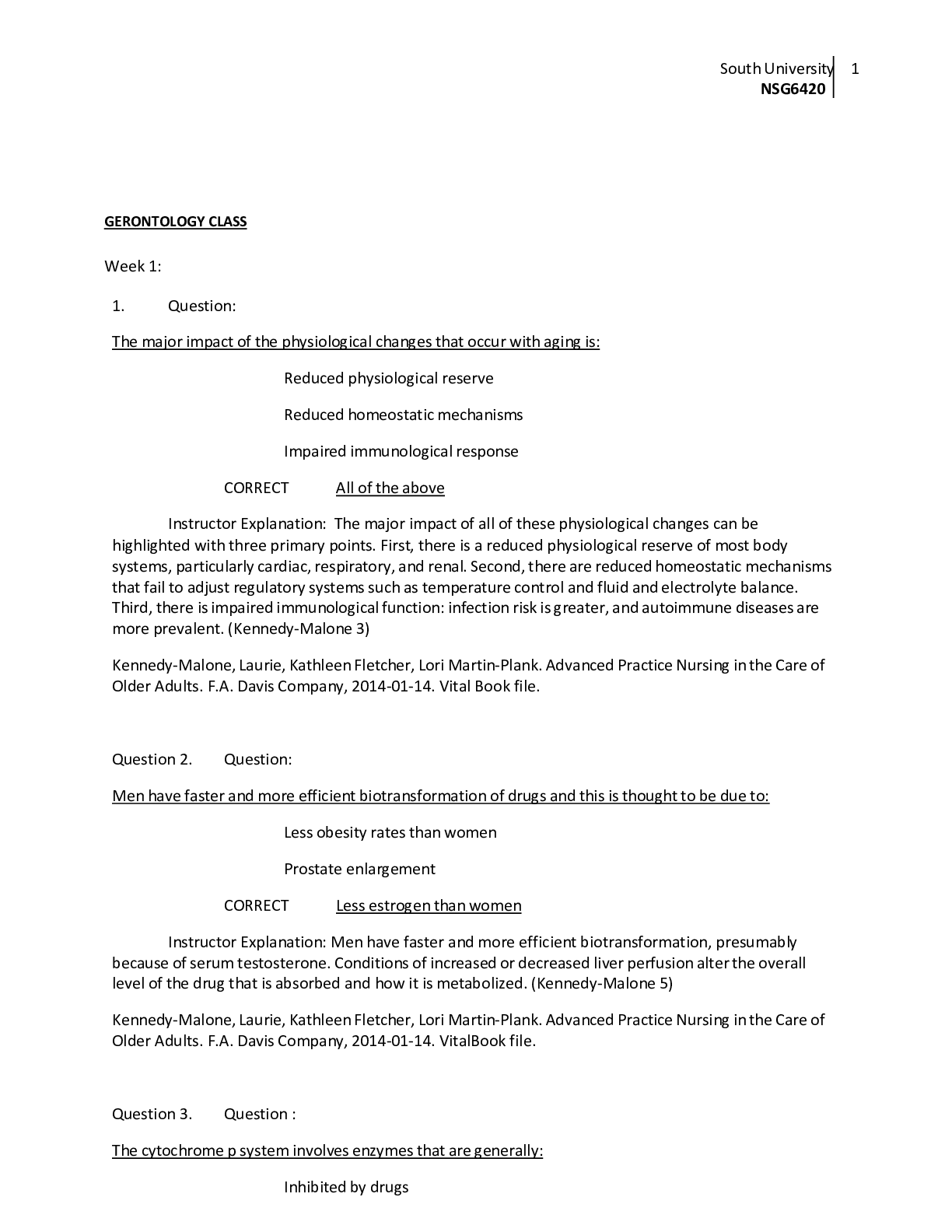
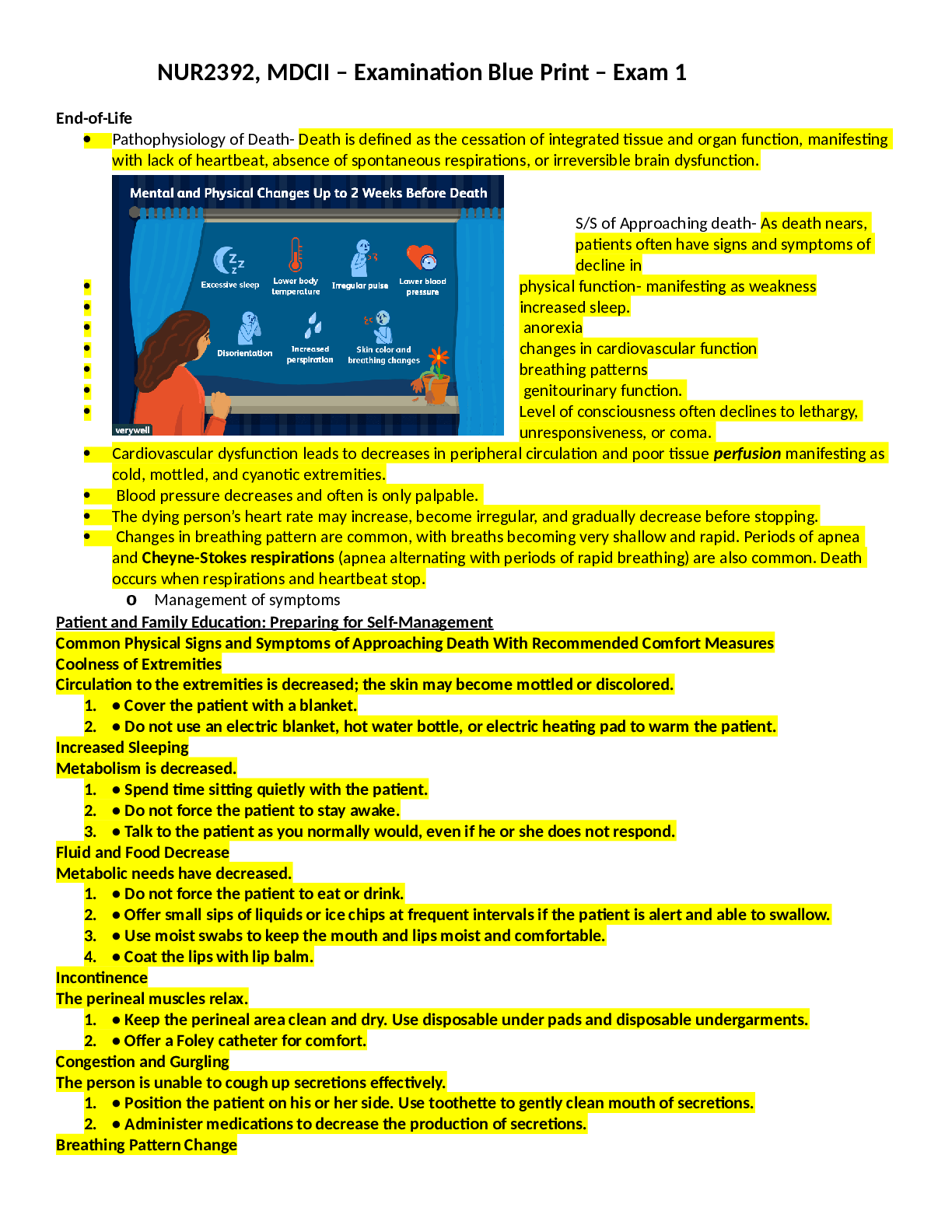
 (1).png)


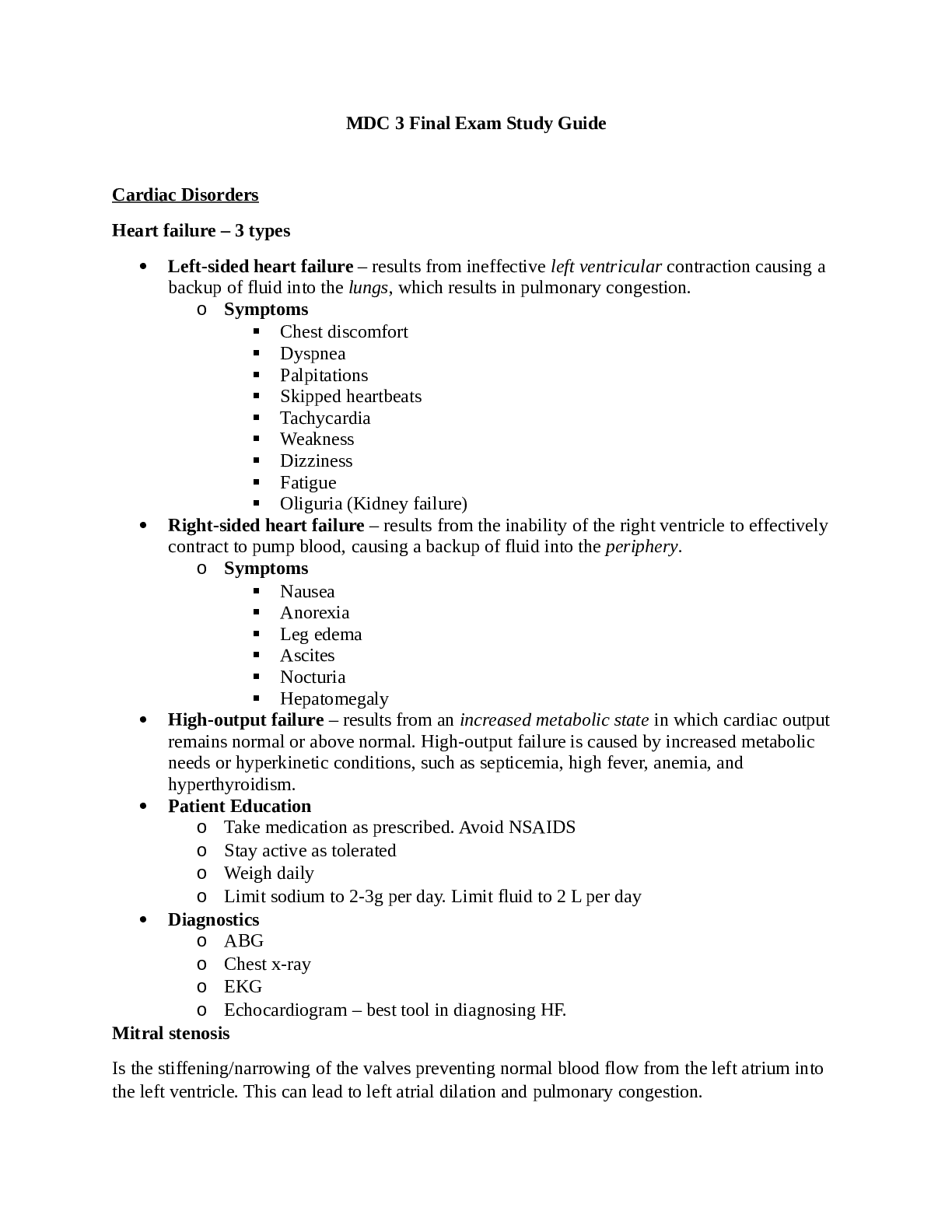
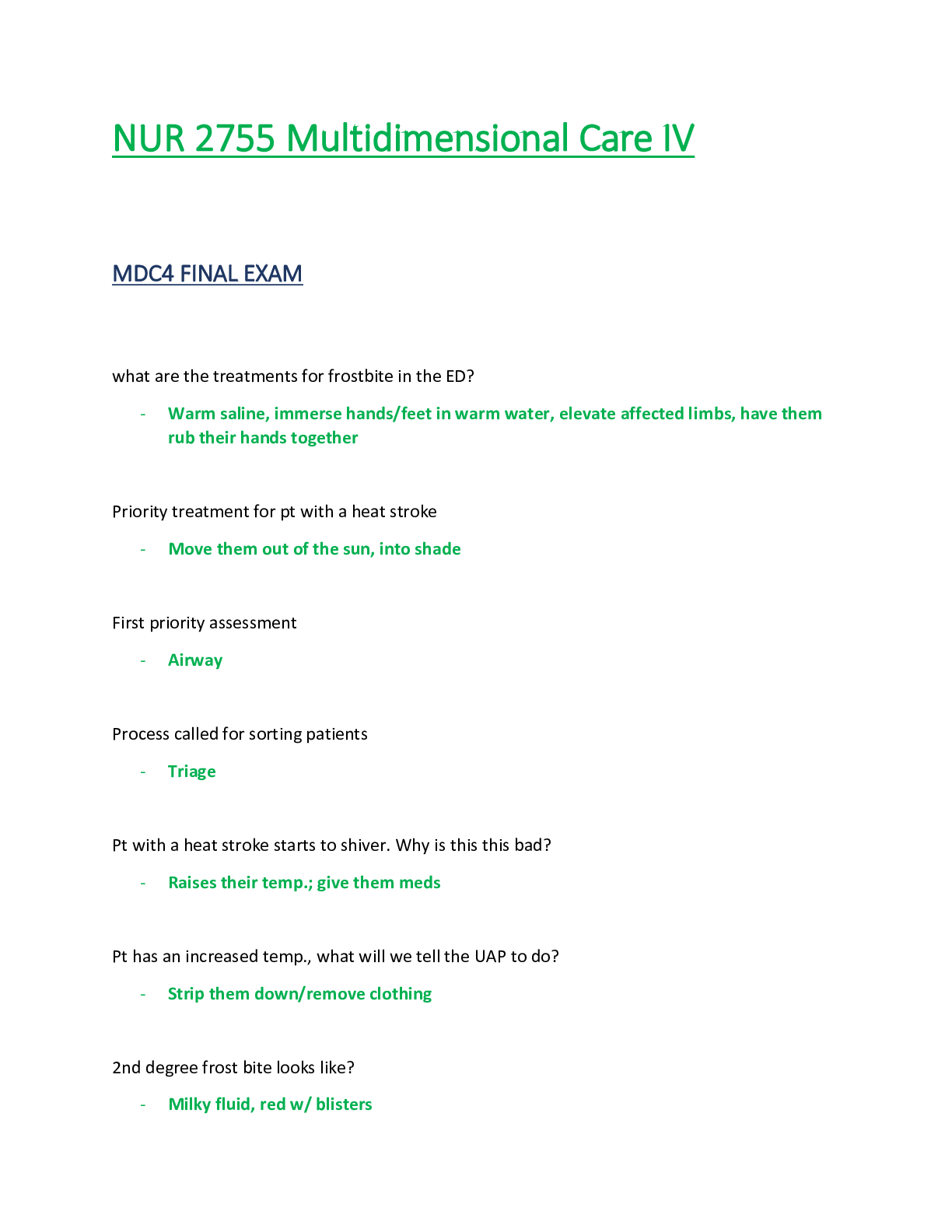
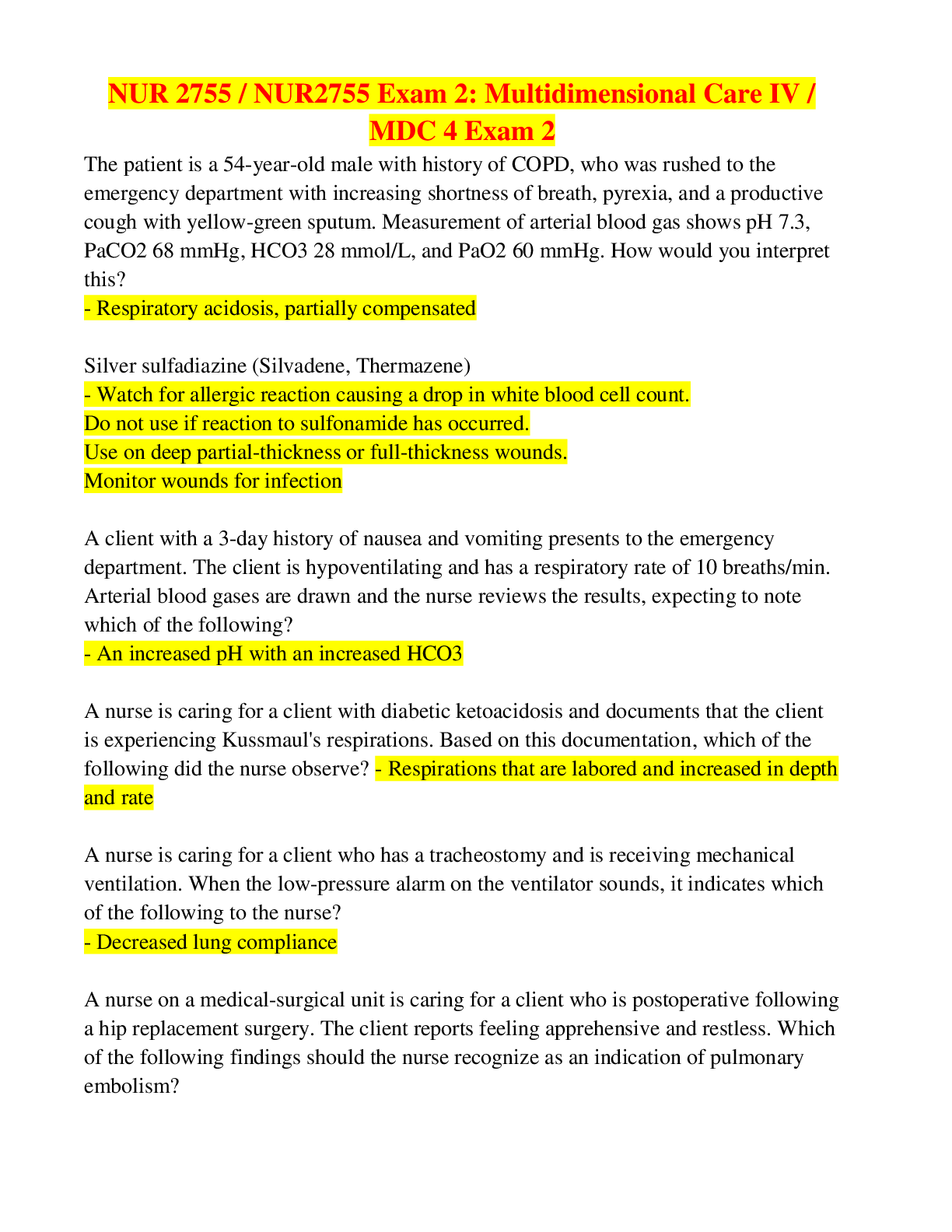
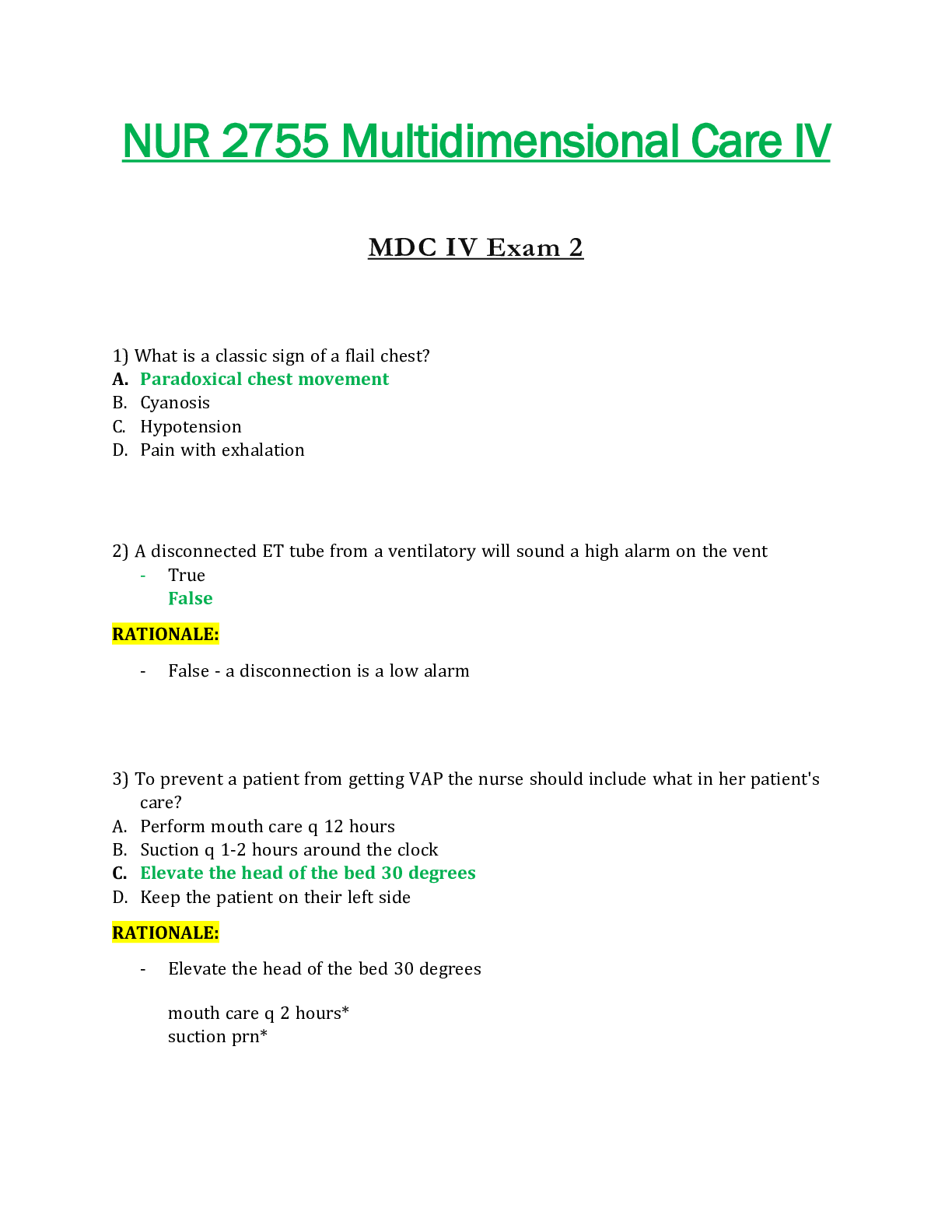
 Rasmussen.png)

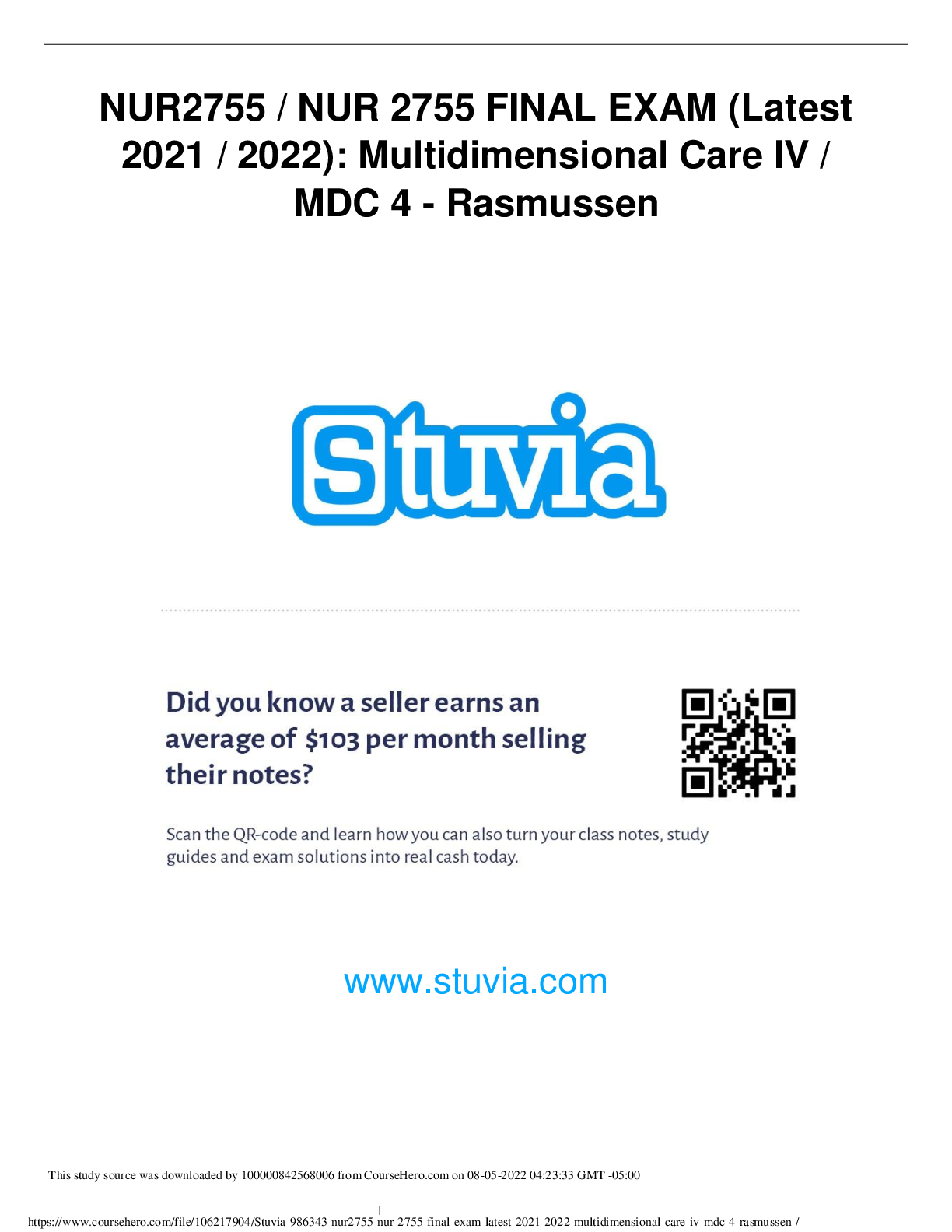
.png)
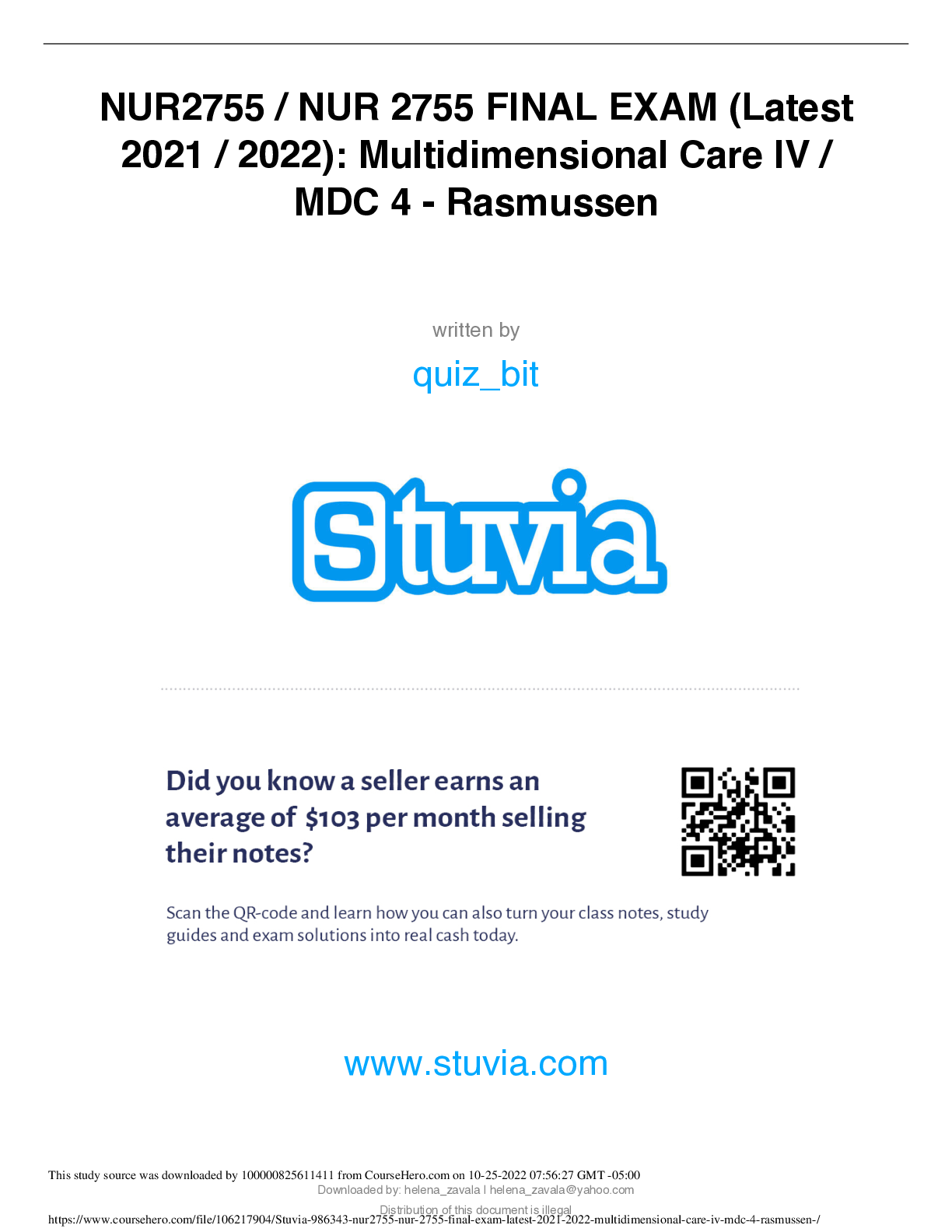
 (1).png)
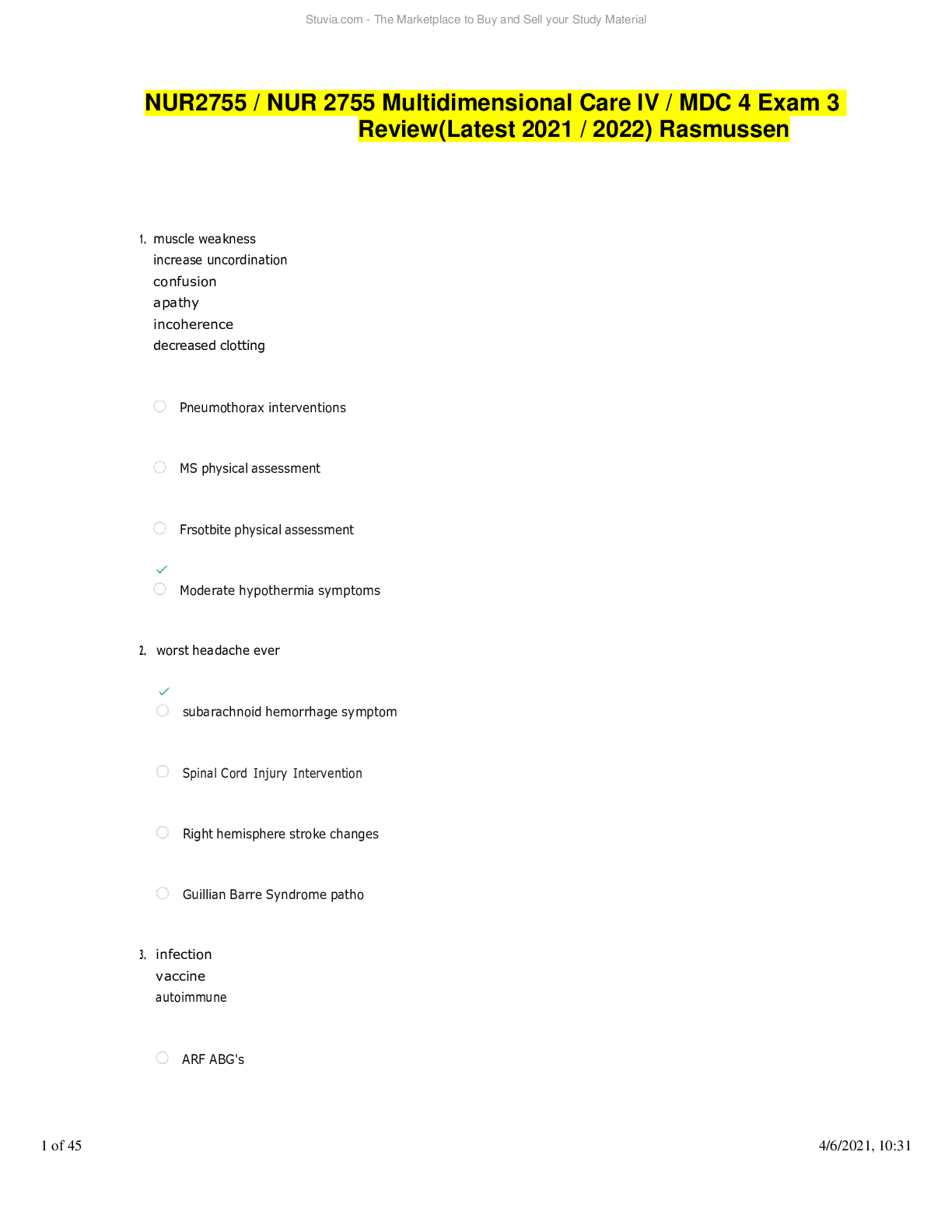
- Multidimensional Care IV _MDC 4 - Rasmussen.png)
 (2).png)
